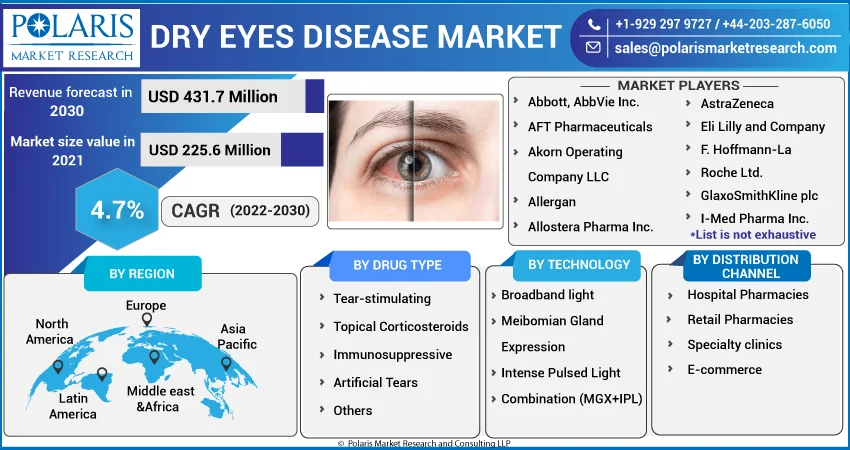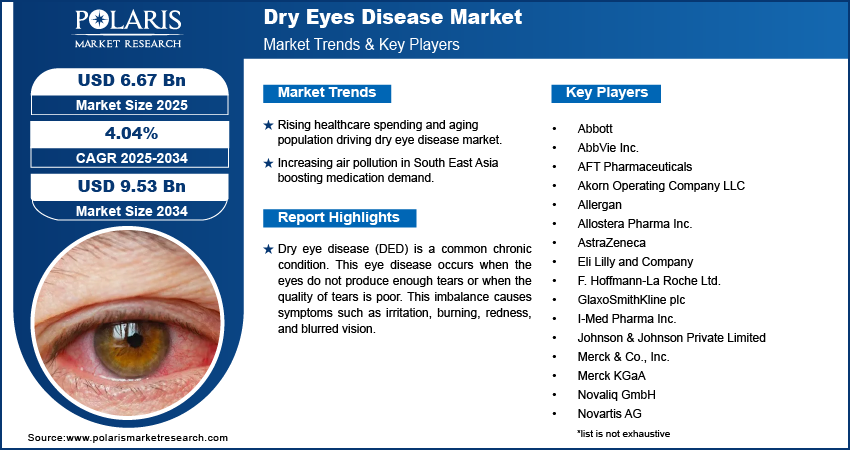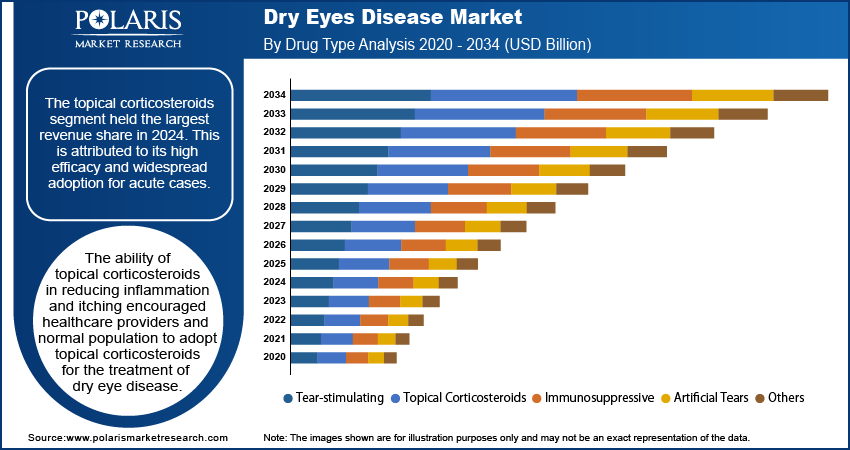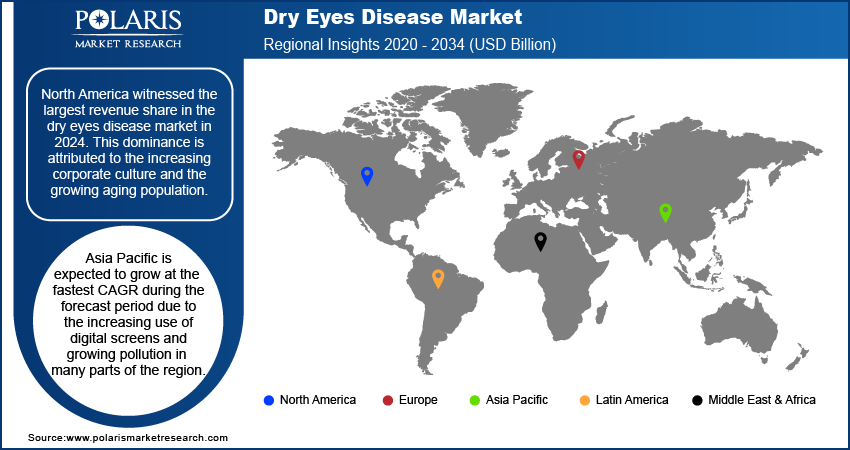
Dry Eyes Disease Market Size, Share, Trends, Industry Analysis Report
By Drug Type (Tear-stimulating, Artificial Tears, Topical Corticosteroids, Immunosuppressive, and Others), By Technology, By Distribution Channel, and By Region -Market Forecast, 2025 - 2034
- Published Date:Sep-2025
- Pages: 114
- Format: PDF
- Report ID: PM1329
- Base Year: 2024
- Historical Data: 2020 - 2023
Overview
The global dry eyes disease market size was valued at USD 6.43 billion in 2024. The market is projected to grow at a CAGR of 4.04% during 2025 to 2034. Key factors driving demand for dry eyes disease include an aging global population, increasing use of digital screens, environmental factors like low humidity and pollution.
Key Insights
- The topical corticosteroids segment held the largest revenue share in 2024. This is attributed to its high efficacy and widespread adoption for acute cases.
- The e-commerce segment is projected to grow at a rapid CAGR in the coming years, owing to its ability to provide convenience and the growing adoption of smartphones.
- North America witnessed the largest revenue share in the dry eyes disease market in 2024. This dominance is attributed to the increasing corporate culture and the growing aging population.
- Asia Pacific is expected to grow at the fastest CAGR during the forecast period due to the increasing use of digital screens and growing pollution in many parts of the region.
Industry Dynamics
- The global dry eye disease market is fueled by increasing healthcare spending and a growing aging population.
- The growth in air pollution in South East Asia, particularly in India and Pakistan, is anticipated to increase demand for dry eye disease medication.
- The growing aging population, especially in developed countries, is creating a lucrative market opportunity.
- Lack of public awareness in various parts of the world may hamper the market growth.
Market Statistics
- 2024 Market Size: USD 6.43 Billion
- 2034 Projected Market Size: USD 9.53 Billion
- CAGR (2025-2034): 4.04%
- North America: Largest Market Share

To Understand More About this Research: Request a Free Sample Report
Dry eye disease (DED) is a common chronic condition. This eye disease occurs when the eyes do not produce enough tears or when the quality of tears is poor. This imbalance causes symptoms such as irritation, burning, redness, and blurred vision. Dry eye disease (DED) can result from aging, hormonal changes, prolonged screen time, environmental factors, certain medications, or underlying health conditions. This disease may damage the corneal surface and affect vision quality, which makes early diagnosis and management essential.
The growing aging population acorss the globe is leading to the market growth. According to a recent data, by 2050, the aging population is expected to grow to 1.5 billion. Aging population are more prone to conditions such as reduced blink rates, hormonal changes. This contribute to dry eye symptoms, requiring the need for effective medication. Moreover, aging population are also more prone to diabetes, arthritis, and glaucoma, which worsen eye dryness, further increasing the prevalence of the condition. According to statistics, about 425 to 430 million people worldwide have diabetes.
Industry Dynamics
Growth Drivers
The growth in air pollution in South East Asia, particularly in India and Pakistan, is anticipated to increase demand for dry eye disease medication. Pollutants such as particulate matter, smoke, dust, and toxic gases disrupt the tear film, and accelerate tear evaporation, leading to a higher prevalence of dry eye symptoms. Moreover, the growing urbanization these countries is also leading to high air pollution, which is increasing the prevalence of dry eye symptoms and creating the demand for dry eye disease medication. According to World Bank Group, India is urbanizing rapidly. By 2036, its towns and cities will be home to 600 million people, or 40 percent of the population, up from 31 percent in 2011. Moreover, increasing awareness-raising initiatives by public and private organizations is estimated to expand the dry eye syndrome treatment market.

Report Segmentation
The market is primarily segmented based on drug type, technology, distribution channel, and region.
|
By Drug Type |
By Technology |
By Distribution Channel |
By Region |
|
|
|
|
Know more about this report: Request for sample pages
Drug Type Insight
The topical corticosteroids segment held the largest revenue share in 2024. This is attributed to its high efficacy and widespread adoption for acute cases. The ability of topical corticosteroids in reducing inflammation and itching encouraged healthcare providers and normal population to adopt topical corticosteroids for the treatment of dry eye disease. Studies have also shown high rates of success of topical corticosteroids in the treatment of dry eye disease, which contributed to the segment's dominance.
The market share of artificial tears for dry eyes is projected to grow at a rapid pace in the coming years, owing to their ability to protect the surface of the eyes. Artificial tears provide immediate and temporary relief for dry eyes symoptoms. This is propelling the growth of the segment. The availablity of artificial tears over-the-counter is also also leading to an increase in segment revenue.

Distribution Channel Insight
Based on distribution channels, e-commerce segment is estimated to hold significant revenue share in 2034. This is attributed to its ability to provide convenience and the growing adoption of smartphones. Patients are now being inclined toward e-commerce distribution channels for comfort, availablity, and prices. The growing usage of smartphones acorss the world is driving the world toward e-commerce platforms that are selling over-the-counter drugs for dry eye syndromes. The growing internet pentration worldwide is further fueling the segment growth.
Regional Insight
North America held the largest market share in 2024. This is attributed to the increasing corporate culture and the growing aging population. According to the Government of Canada Statistics Report 2019, Canada's elderly population has reached 6,592,611, accounting for 17.5% of Canada's population. The increasing the use of computers or digital screens, driven by rising corporate culture also contibuted to the regional dominance, as the high use of computers or digital screens causes DED symptoms. Moreover, the high healthcare spending and established healthcare infrastructure in the region, especially in the U.S. fueled the market dominance in 2024.
Asia Pacific is expected to grow at the fastest CAGR during the forecast period due to the increasing use of digital screens and growing pollution in many parts of the region. Pollutants such as particulate matter, smoke, and dust disrupt the tear film, and accelerate tear evaporation, leading to a higher prevalence of dry eye symptoms. The growing medical toursim in many parts of the region such as India is also leading to the market growth in the region. For instance, the total number of Foreign Tourist Arrivals (FTAs) for medical purposes in India during 2025 (up to April) is 1,31,856, which constitutes approximately 4.1% of the total FTAs during this period. Moreover, the growth in urbanization in the region is further propelling the market growth. The urban population in Asia is expected to grow by 50% by 2050, according to the United Nations Human Settlements Programme.

Competitive Insight
Some of the major players operating in the global dry eyes disease market include Abbott, AbbVie Inc., AFT Pharmaceuticals, Akorn Operating, Company LLC, Allergan, Allostera Pharma Inc., AstraZeneca, Eli Lilly and Company, F. Hoffmann-La Roche Ltd., GlaxoSmithKline plc, I-Med Pharma Inc., Johnson & Johnson Private Limited, Merck & Co., Inc., Merck KGaA, Novaliq GmbH, Novartis AG, Otsuka America, Pharmaceutical, Inc., Pfizer Inc., Sanofi, Santen Pharmaceuticals Co. Ltd., Teva Pharmaceutical Industries Ltd., and Others.
Recent Developments
- In January 2022, Sun Pharma announced the launch of its treatment product, Cequa, in Canada. This is the first dry eyes treatment offered by Nanomicellar (NCELL) technology. This technique improves the bioavailability and physicochemical stability of cyclosporine and enhances its penetration into the eyes tissue.
- In January 2022, NovaBay Pharmaceuticals launched Avenova Lubricating Eye Drops to treat the symptoms of dry eyes.
Dry Eye Disease Market Report Scope
|
Report Attributes |
Details |
|
Market size value in 2024 |
USD 6.43 billion |
| Market size value in 2025 | USD 6.67 billion |
|
Revenue forecast in 2034 |
USD 9.53 billion |
|
CAGR |
4.04% from 2025 - 2034 |
|
Base year |
2024 |
|
Historical data |
2020 - 2023 |
|
Forecast period |
2025 - 2034 |
|
Quantitative units |
Revenue in USD Billion and CAGR from 2025 to 2034 |
|
Segments covered |
|
|
Regional scope |
|
|
Key companies |
Abbott, AbbVie Inc., AFT Pharmaceuticals, Akorn Operating, Company LLC, Allergan, Allostera Pharma Inc., AstraZeneca, Eli Lilly and Company, F. Hoffmann-La Roche Ltd., GlaxoSmithKline plc, I-Med Pharma Inc., Johnson & Johnson Private Limited, Merck & Co., Inc., Merck KGaA, Novaliq GmbH, Novartis AG, Otsuka America, Pharmaceutical, Inc., Pfizer Inc., Sanofi, Santen Pharmaceuticals Co. Ltd., Teva Pharmaceutical Industries Ltd |
Browse Our Top Selling Reports:
Monoclonal Antibodies In Veterinary Health Market Size, Share 2024 Report
Dental Inlays & Onlays Market Size, Share 2024 Report
Cell-free Protein Expression Market Size, Share 2024 Report
FAQ's
• The global market size was valued at USD 6.43 billion in 2024 and is projected to grow to USD 9.53 billion by 2034.
• The global market is projected to register a CAGR of 4.04% during the forecast period.
• North America dominated the market in 2024.
• A few of the key players in the market include Abbott, AbbVie Inc., AFT Pharmaceuticals, Akorn Operating, Company LLC, Allergan, Allostera Pharma Inc., AstraZeneca, Eli Lilly and Company, F. Hoffmann-La Roche Ltd., GlaxoSmithKline plc, I-Med Pharma Inc., Johnson & Johnson Private Limited, Merck & Co., Inc., Merck KGaA, Novaliq GmbH, Novartis AG, Otsuka America, Pharmaceutical, Inc., Pfizer Inc., Sanofi, Santen Pharmaceuticals Co. Ltd., Teva Pharmaceutical Industries Ltd.
• The topical corticosteroids segment dominated the market revenue share in 2024.
